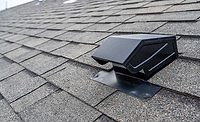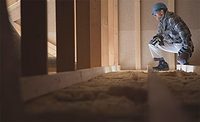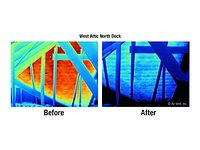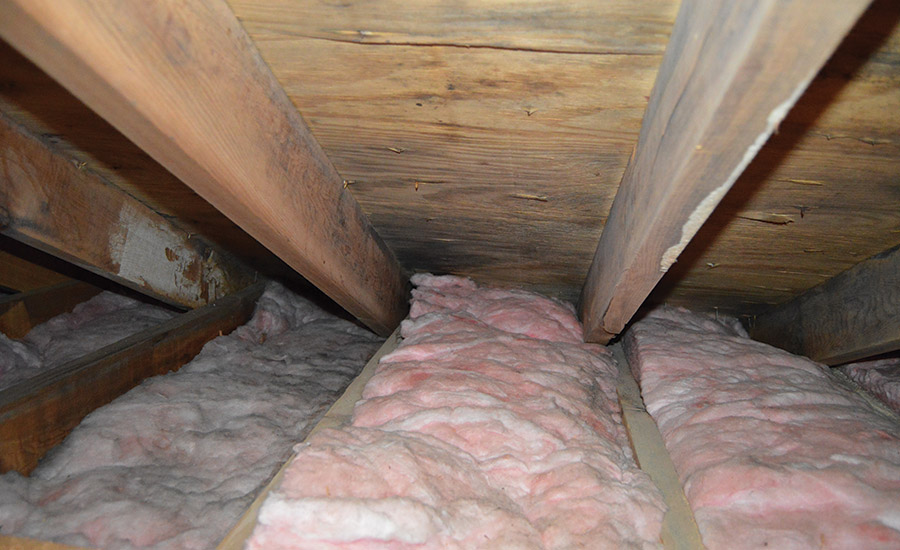Standing Out in a Crowded Market: Roofing Contractors Use Attic-Ventilation Inspections to Differentiate Themselves From Competitors


Attic-insulation baffles could have been used here to prevent the insulation from blocking the intake vents. Photo courtesy of Sam Rosario, Liberty Construction Inc., Worcester, Mass.

Darkened wood members inside the attic indicate excessive moisture. Photo courtesy of Sam Rosario, Liberty Construction Inc., Worcester, Mass.



For residential roofing contractors, there are multiple excellent reasons to conduct an attic-ventilation inspection — as long as it’s safe and practical to do so. Perhaps none of them carries more weight than this bottom-line perspective from Sam Rosario, president of Liberty Construction Inc. in Worcester, Mass.
“The value of inspecting an attic is critical to my business,” he said. “We will use it against all other contractors who don’t do an attic inspection. ‘Would you trust a doctor who doesn’t examine a patient yet recommends surgery?’ we ask homeowners.”
Air Vent asked attendees of its Attic Ventilation: Ask the Expert™ seminars (offered free to the residential roofing industry every first quarter) to pinpoint specifically what they look for during attic-ventilation inspections and why; how homeowners react to the inspections; and to explain the impact the inspections have on their businesses.
The Checklist
Our panel of roofing contractors identified the following checkpoints for a thorough attic-ventilation inspection.
- Match the roof design to the best attic-ventilation option possible.
- How many attics are there? Are they common to each other or separate?
- Identify physical obstructions (firewalls, knee walls, etc.) that would impact airflow, and make appropriate recommendations.
- Check that the amount of intake and exhaust ventilation (including spacing and positioning of the vents) has been correctly sized based on the attic square footage.
- Check the attic temperature compared to the outdoor ambient temperature. If the attic ventilation system is working properly, the attic temperature should be no more than 15-20 degrees Fahrenheit higher than the temperature outdoors.
- Is anything obstructing the intake vents such as insulation, debris or paint?
- Is the exhaust vent operating properly (examples: power fan motor, spinning wind turbines, etc.)?
- Are attic-insulation baffles being used to help keep the intake vents clear and free?
- Is the system being short-circuited due to a mixture of two or more different types of exhaust vents?
- Is the attic insulation the correct R-value for the geographic location? Has the insulation become compacted and thus lost some of its R-value?
- Are the bathroom fans correctly vented to the outdoors through the roof or sidewall (not ducted to terminate inside the attic or near soffit/intake vents)?
- Are there signs of rust or discoloration on the nails that penetrate the underside of the roof deck?
- Is the roof deck warped? What does the underside of the deck look like? Are there any signs of delamination?
- In cold climates, look for signs of frost or snow including the framing members, underside of the deck and attic insulation.
- Are there any signs of mold or mildew inside the attic? What does the attic smell like? What does it feel like? (“Most mold smells can be detected, and the humidity can be felt once inside the attic,” said Rosario).
“I look first at the design of the roof,” said Jason Avery, owner of Lakefront Roofing and Exteriors, in Covert, Mich. “Is it a ranch house with gables or hips, an old farm house with knee walls or a newer cut-up house with multiple attic locations?” He explained that understanding the roof design sets the stage for matching the appropriate attic-ventilation system to the project.
“I’m looking to see if the attic-ventilation system already in place is optimum,” said Jake Jacobson, vice president of SF5 Construction in Little Elm, Texas. “If it appears they currently have an optimum system, I then check to see if it’s working properly. If it’s not, how can I improve it?” Jacobson uses the Attic Ventilation Inspection Pad to assist with his inspections. It’s a tool given to seminar attendees.
“Our company has made it a point to check every attic. Among the many areas we are looking at include any visible signs of leaks that the homeowners may not be aware of,” said Jeff Heitzenrater, vice president of operations for Triple Peaks Roofing & Construction Inc. in Westlake, Ohio. “We check for proper soffit ventilation, if the bathrooms are vented properly and if the insulation is correct for this region of the country.”
“We always do an attic inspection if there is an attic,” said Pete Curtis, owner of Mountain Peak Home Improvements in Council Bluffs, Iowa. “We look for water staining, delamination of plywood, compacting of insulation, the amount of insulation, the presence of mold and the presence of more than one attic area. We are looking for problems related to poor attic ventilation, which need to be addressed during the roof replacement.”
Appearances Can Be Deceiving
Just because the attic vents are in place and in view doesn’t mean they’re working. Among the most frequent and troublesome culprits reducing attic-ventilation airflow is obstructed intake vents. Each of the roofers we polled listed this as a critical checkpoint during an attic-ventilation inspection.
“Not only do I check if the amount of intake is adequate, but also that the intake vents are not covered with insulation so they can allow for proper airflow to the exhaust vents,” explained Sean Jegen, owner of Gorilla Exteriors Contracting LLC in Shawnee, Kan.
Stan Robinson, owner of Pacific West Roofing in Tualatin, Ore., has a series of questions he asks himself during each attic inspection. “How much net-free area of intake is currently being delivered into the attic space freely without obstruction? If there is enough NFA of intake, what obstructions need to be removed? If there is not enough NFA, how many additional intake vents need to be added along with insulation baffles?”
Triple Peaks Roofing & Construction confirms the intake vents are obstruction free via the daylight test. “Inside the attic, we look at the soffit area with the lights out during daytime hours. If the intake vents are clear and free, we’ll see daylight coming in through the vents,” Heitzenrater said. “If we don’t see daylight, something is blocking the intake vents.”
Helping Homeowners
Attic-ventilation inspections help identify the full scope of the work to be done before the project actually begins, regardless of why the homeowner originally asked the roofing contractor to come to the house. This helps with pricing the work, scheduling it, explaining it to the homeowner and the all-important homeowner buy-in.
“Attic inspections help the homeowner understand the need for ventilation even if they never had it before,” said Heitzenrater. “It takes the guess work out of the equation for both the homeowner and the contractor. Most homeowners are happy to pay for the things that are needed once explained with an attic inspection and photos.”
“An attic-ventilation inspection is of vital importance,” Curtis said. “It enables us to deal with the most common cause of premature roof failure, enables the homeowner to enjoy the security of having a manufacturer’s warranty, and makes it possible for us to design and install a system which will provide good ventilation — allowing for comfort and energy savings for many years.”
According to Avery, being thorough pays off. “The homeowner gains confidence in me as their salesperson and in my company in general,” he said. “They realize we are efficient in looking at all areas of the roofing project. They see we have the knowledge and willingness to provide them with the best roof available for what is likely their largest investment: their home.”
Attic-ventilation inspections increase a homeowner’s confidence in the contractor. Increased confidence builds loyalty. Loyalty leads to repeat business and referrals. “Attic ventilation inspections separate us from the competition,” said Robinson. “We are the ventilation experts in the eyes of the homeowner.”
“It’s just the right thing to do,” agreed Jacobson. “Especially since the homeowner is counting on you to be a professional and take care of their complete roofing needs. It also legitimizes us as roofing professionals, and shows we go beyond just installing a new roof and moving on to the next job.”
Solutions, Not Surprises
“We’re a small roofing company, and all of our competition do not go into the attic,” said Anthony Davis, project manager for Williams Roofing and Construction LLC in Mountlake Terrace, Wash. “And if they do go into the attic, nine out of 10 times they do not address the fact that the plywood will need replacing. That alone sets us apart from the competition. We include plywood replacement in our estimates if it’s needed. People are spending a lot of money on their roofs. It’s a huge investment for years to come, and we want to do it right for them. That’s why we address intake and exhaust ventilation in every estimate. And it all begins with the attic inspection. Homeowners don’t want surprises. They want solutions. That’s our goal.”
Sometimes it all boils down to common sense. “A thorough attic-ventilation inspection is necessary in order to qualify for long-term warranties from manufacturers. Also, the International Residential Building Code requires attic ventilation,” Rosario said. “But most of all, common sense takes over because the most cost-effective time to address attic ventilation is during the upcoming roof project. And the attic-ventilation inspection identifies that upfront.”
Looking for a reprint of this article?
From high-res PDFs to custom plaques, order your copy today!








